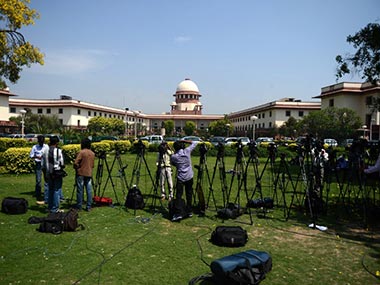“Reform that you may preserve”. Those parting words of the lone dissenting judge J Chelameswar, quoted from the speech of Macaulay, were not a mere reflection of an individual’s angst against the judiciary acquiring authoritarian and often despotic traits on the pretext of protecting the “basic structure” of the Constitution; they were also a pointer to the method in the madness in the entire process. The five-member bench that struck down the NJAC and constitutional amendment has also referred to the “insularity and independence of judiciary” as an intrinsic feature of the “basic structure” of the Constitution. In the court’s view, judicial independence would be compromised if the executive gains an influence in the appointment of judges. [caption id=“attachment_2472404” align=“alignleft” width=“380”] Representational image. AFP[/caption] But was there any doctrine like the “basic structure” in the Constitution in the first place? Of course not. The genesis of this doctrine in its nebulous state could be traced to a litigation on abolition of Zamindari in Bihar passed by the Constituent Assembly in the post-Independence period. The Patna High Court scrapped the Act and held that since the “right to property” was a fundamental right, it could not be taken away by legislative action. The Constituent Assembly amended the Act and created the ninth schedule to insulate land reforms legislation from judicial scrutiny. The judges, however, sowed the seed of the “basic structure” doctrine by questioning Parliament’s authority to legislate on what is called “fundamental rights”. However, constitutional amendment was regarded as beyond the pale of judicial review till the Golakhnath case came into existence in the early sixties. Once again, the case was related to the acquisition of surplus land by the state in violation of the “fundamental right to property”. For the first time though the SC did not give any relief to the petitioner, it retained its right to review the constitutional amendment if it infringes on fundamental right. The SC’s decision was clearly violative of the basic principle of the Constitution that defines laying down prospective law as exclusive domain of the legislature. In the Golakhnath case, the SC armed itself with the authority to subject any amendment to its critical scrutiny. Many scholars of the Constitution found fault with the judgment on the ground that though it gave no relief to petitioner, it drew solace from the fact that the future generation would be benefitted by it. Apparently the SC premised its judgment on a political philosophy rather than legal propositions. Since it was clearly usurpation of legislative domain, there was an apprehension that tyranny of the SC would be no less oppressive than any political tyranny. But the 1970s were the times of a single-party monopoly and Indira Gandhi exuded absolute authority. In this context when respected legal scholar Nani Palkivala took up the case of Keshvanand Bharti of Kerala Mutt, he seemed to be challenging the possibility of over-reach by Parliament in curbing fundamental rights through legislation. He contended that Parliament, which is a creature of the Constitution, does not have the unfettered power to re-write it. A 13-member bench then drew logic from the Golakhnath judgment and propounded the doctrine of “basic structure” that remains yet. In the recent judgment on NJAC, the court relied on vagueness of the “basic structure” to do exactly what it had originally opposed to do in the Keshvanand Bharti case. The apex court is not only the sole and final arbiter in the matter of constitutional interpretation but it also assumed the authority to re-write the Constitution on the pretext of “basic structure”. Given the fractious politics of the country in the past two decades, the SC used it for essentially non-judicial purposes and extended its frontiers to the domains of the legislature and the executive. The fear expressed by the SC on political influence on judges’ appointment is clearly unfounded in today’s political context where one party-dominance like in the 1970s is not the reality. On the other hand, there are several instances of judicial indiscretions that call for a check on the unfeterred power acquired by the higher judiciary. Is it not a fact that there were serious cases of non-adherence to moral and ethical conduct against CJIs? Is it not a fact that high court judges found involved in bribery cases cocked a snook at the criminal justice system by sticking to their posts? Is it not a fact that the SC has assumed the role of creating regulatory authorities and appointing retired judges as its custodians, by overlooking the normal process? In Delhi’s Lutyen’s zone, bungalows are majorly occupied by many retired members of the higher judiciary. Not long ago, in Uttar Pradesh, the High Court decided on its own perks and privileges through judicial orders. There are umpteen cases of brazen transgression by higher judiciary into domains considered to be the preserves of the executive and the legislature. Union Finance Minister Arun Jaitley has rightly pointed out the irony of unelected judges assuming the role of protector of the Constitution from elected representatives
in his latest blog . In fact, the fear expressed about the possibility of establishing a “judicial tyranny” in a fractious political context is very distinct. The difference is that during Emergency (the period of political tyranny) it took rulers only 14 months to realise the futility of pursuing an autocratic goal. But it will be difficult to predict as to how this new variant of authoritarianism will take shape.
The five-member bench that struck down the NJAC and constitutional amendment has also referred to the “insularity and independence of judiciary” as an intrinsic feature of the “basic structure” of the Constitution. In the court’s view, judicial independence would be compromised if the executive gains an influence in the appointment of judges.
Advertisement
End of Article


)
)
)
)
)
)
)
)
)



